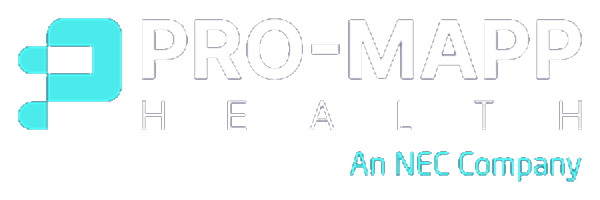This is the second in a series of blogs around PRO-MAPP’s (and the wider healthcare industry’s) actionable uses of AI. You can find the introductory background article here, as well as Part One around waiting list monitoring and management here.
How does a healthcare system achieve ultimate customer satisfaction? These days, it’s achieved through personalising a patient’s journey, from understanding an initial health problem to finding a beneficial solution.
Determining that pathway goes beyond knowing exactly what their symptoms are at that point in time. Instead whole medical histories outline lifestyle choices, personal preferences for treatment, past assessments and surgeries, and everything that providers need to be able to tailor any patient’s care requirements with a personal touch. This personalisation marks a huge difference to make every patient feel thought about; it opens a transparent, comfortable dialogue between them and a healthcare professional from the pathway’s very outset.
But since the arrival of Electronic Medical Records (EMRs), there’s been an overwhelming explosion of data in the healthcare industry for every registered citizen. When you apply that to a nationwide database, such as that of the NHS, it shows the extent of how much personal data is out there. Collating pathways has been a major challenge, and this is where we see a pivotal use case for healthcare AI.
Traditional technology’s insufficient impact
Given today’s potential for advanced data usage, patients have a weight of expectation for the level of bespoke care they receive. Unfortunately this only compounds the difficulty level of operational efficiency faced by the NHS blighted by backlogs and budget constraints.
A streamlined end-to-end clinical workflow per patient comprises resource and task allocations across whole teams. That begins with a clean data repository to make every pathway matter. The trouble with old-school healthcare IT being monolithic systems is not only their large-scale and costly implementations, but their role for storing EMR information still being ineffectual due to siloed and underutilised patient data.
Their lack of flexibility and precision has pervaded as patient backlogs have extended. This is particularly true in the heavy-hit specialism of orthopaedic surgeries; helping complex patients receive pre-habilitation assessment, surgery and post-surgical analysis cries out for real-time data gathering and visualisation. Understanding successes and failures of past surgeries helps clinicians delivery a greater level of service for those in lengthy orthopaedic pathways – and when these insights are collated in nationwide databases, a framework can be applied for better patient outcomes en masse and remove clinic-to-clinic variations.
Surgical evidence offered by AI
The future for standardised pathway success lies in the metrics still, just using speedier automation technology to collect it, and simpler ways to surface and cross-reference each patients’ preferences and health histories immediately. When performance data audits can be collated by AI and housed in a comprehensive database, different arms of the NHS can use such information as a gold standard for orthopaedic surgery pathways.
AI is therefore a boon for registries in its tracking capabilities. It can scan demographics, as well as each patient’s preferences when it comes to each stage of treatment, then segment them for healthcare providers to view when necessary. Particularly when this data is gathered via patient self-reporting, such personalised choices are accurate; in fact, recent studies have shown that patients preferred the empathy and quality of AI-generated social media replies than that of clinicians, identifying the tool’s growing sophistication in increasing satisfaction.
The predictive analytics of AI may feel one of its more alien features. Essentially AI is able to identify potential risks for patients pre-surgery to make sure expectations are laid out upfront, as well as supply directions for seeking further advice, or tweaking lifestyle choices, according to collected medical notes and discharge summaries in post-operative stages. So-called ‘prepared lists’ get automated, ready for trained staff to educate waiting list patients on treatment benefits, risks and alternatives. It limits the operational times spent on producing reports, while laying out accurate predictions for continued care.
PRO-MAPP’s AI journey
Human-led one-to-one care is the ultimate driver of patient satisfaction, and that can be made seamless with administrative tasks eased by AI. PRO-MAPP offers an end-to-end AI-backed solution that enables the design and execution of tailored patient pathways to address high-levels of detail to individual needs:
- The platform collates eOpNote, Patient-Reported Outcome Measures (PROMs) and barcode scans to craft dynamic dataset visualisations.
- Our review by the York Health Economics Consortium (YHEC) identified the strength of AI applications in collected self assessments and diagnostics to ensure complex patients receive treatment sooner and ease unnecessary appointment numbers.
- Complex patients can be determined with an accuracy rating of 98%.
- AI is able to capture every insight from a surgical workflow in real-time, from resource utilisation to outcome-affecting variables, to offer opportunities for clinical support and pathway improvement.
- We’ve achieved a target reduction in length of stay of half a day for pre-hab patients, saving £423,500.
- Our platform has helped increase physiotherapy appointments, adding more than 320 than standard pathways.
AI’s automation is so key for a number of integral changes to improve the NHS. Fast-tracking in-need orthopaedic patients reduces the spend on unnecessary appointments that have stifled the system, and sees the right resources being allocated to the correct surgical practices. More productive healthcare teams are able to make their level of care go further with administrative burdens taken on by AI, and focus on what matters – improving the outcomes and results for patients. A happier health system means happier patients, and AI is marking a turning point in evolving orthopaedic surgery to meet those expectations for advanced care.
Next in the series, we’ll be delving into AI’s speedy adaptability to help health centres conduct same day pre-assessment. To find out more about how PRO-MAPP’s AI use drives personalised patient pathways, get in touch!








